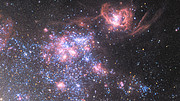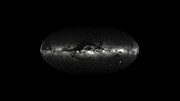Credits: NASA/NICER.
In this image, numerous sweeping arcs seem to congregate at various
bright regions. You may wonder: What is being shown? Air traffic routes?
Information moving around the global internet? Magnetic fields looping across active areas on the Sun?
In fact, this is a map of the entire sky in X-rays recorded by NASA’s Neutron star Interior Composition Explorer (NICER),
a payload on the International Space Station. NICER’s primary science
goals require that it target and track cosmic sources as the station
orbits Earth every 93 minutes. But when the Sun sets and night falls on
the orbital outpost, the NICER team keeps its detectors active while the
payload slews from one target to another, which can occur up to eight
times each orbit.
The map includes data from the first 22 months of NICER’s science
operations. Each arc traces X-rays, as well as occasional strikes from
energetic particles, captured during NICER’s night moves. The brightness
of each point in the image is a result of these contributions as well
as the time NICER has spent looking in that direction. A diffuse glow
permeates the X-ray sky even far from bright sources.
This image of the whole sky shows 22 months of X-ray data recorded by
NASA's Neutron star Interior Composition Explorer (NICER) payload aboard
the International Space Station during its nighttime slews between
targets. NICER frequently observes targets best suited to its core
mission (“mass-radius” pulsars) and those whose regular pulses are ideal
for the Station Explorer for X-ray Timing and Navigation Technology
(SEXTANT) experiment. One day they could form the basis of a GPS-like
system for navigating the solar system. Credits: NASA/NICER. Download full-resolution images from NASA Goddard’s Scientific Visualization Studio
The prominent arcs form because NICER often follows the same paths
between targets. The arcs converge on bright spots representing NICER’s
most popular destinations — the locations of important X-ray sources the
mission regularly monitors.
“Even with minimal processing, this image reveals the Cygnus Loop,
a supernova remnant about 90 light-years across and thought to be 5,000
to 8,000 years old,” said Keith Gendreau, the mission’s principal
investigator at NASA’s Goddard Space Flight Center
in Greenbelt, Maryland. “We’re gradually building up a new X-ray image
of the whole sky, and it’s possible NICER’s nighttime sweeps will
uncover previously unknown sources.”
NICER’s primary mission is to determine the size of dense remains of dead stars called neutron stars — some of which we see as pulsars
— to a precision of 5%. These measurements will finally allow
physicists to solve the mystery of what form of matter exists in their
incredibly compressed cores.
Pulsars, rapidly spinning neutron stars
that appear to “pulse” bright light, are ideally suited to this
“mass-radius” research and are some of NICER’s regular targets.
Other frequently visited pulsars are studied as part of NICER's Station Explorer for X-ray Timing and Navigation Technology (SEXTANT)
experiment, which uses the precise timing of pulsar X-ray pulses to
autonomously determine NICER’s position and speed in space. It’s
essentially a galactic GPS system. When mature, this technology will
enable spacecraft to navigate themselves throughout the solar system —
and beyond.
NASA's Goddard Space Flight Center, Greenbelt, Md.
Media contact:
Claire Andreoli
NASA's Goddard Space Flight Center, Greenbelt, Md.
Editor: Rob Garner
Source: NASA/NICER


























